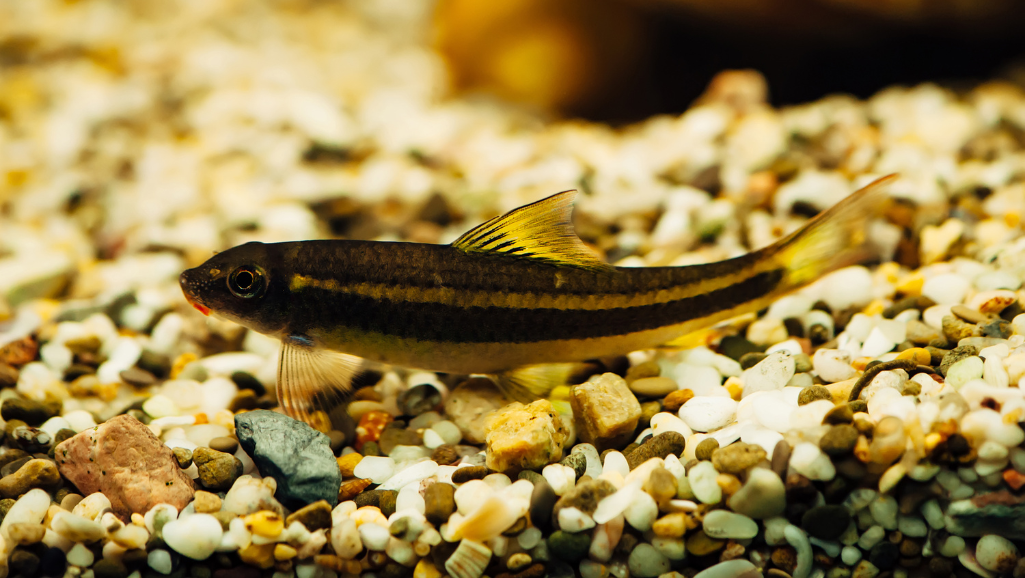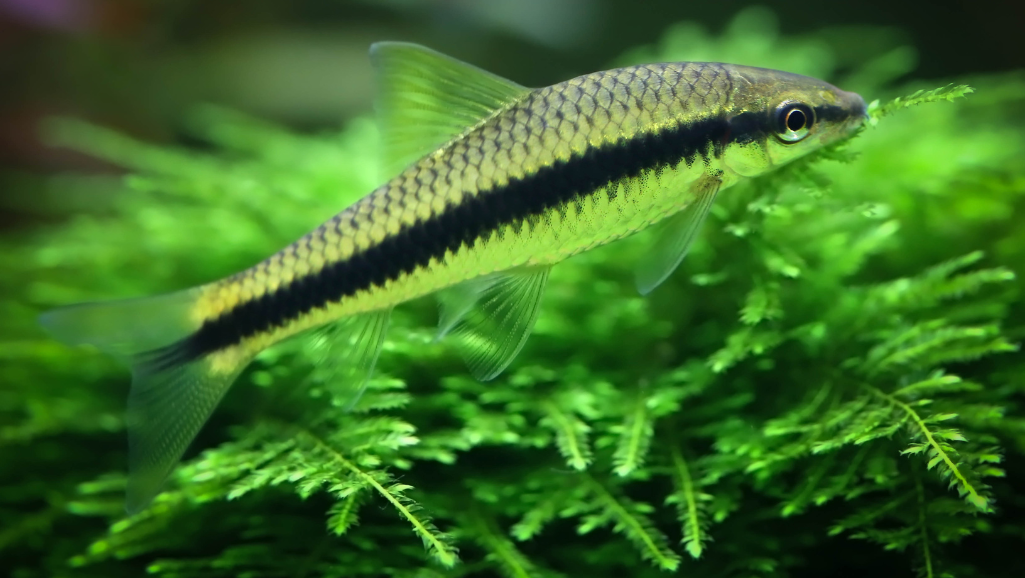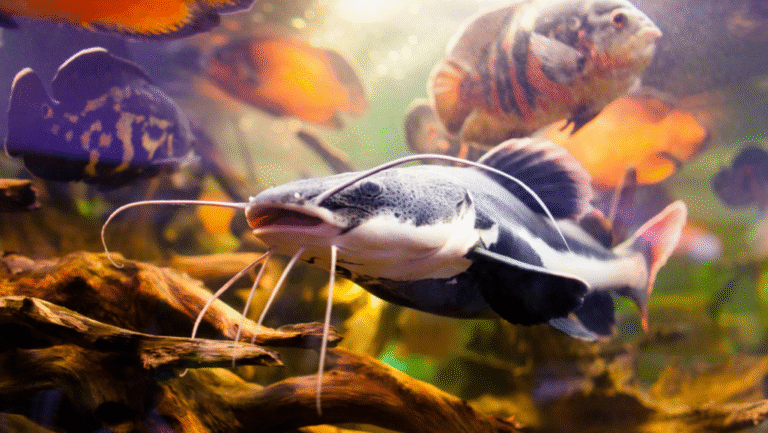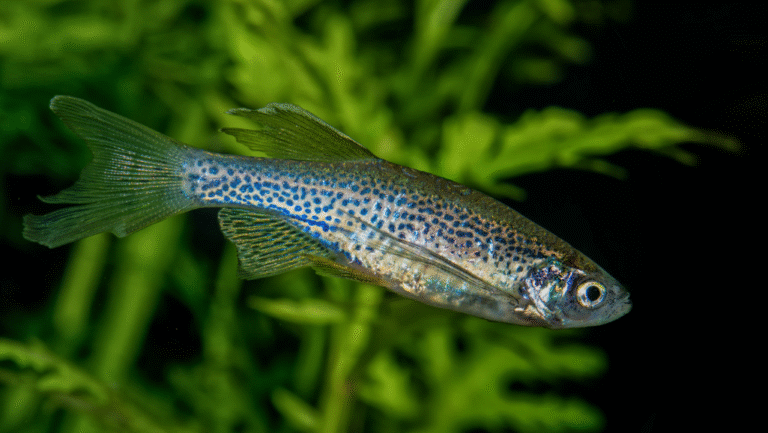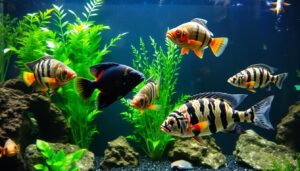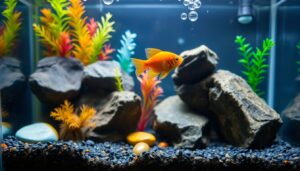The Siamese Algae Eater is known for keeping Freshwater Aquarium Fish tanks clean. These colorful fish help keep Pristine Aquariums clear by eating algae. They are key to keeping the water and life in the tank healthy.
They are experts at eating algae that other fish can’t. This makes them a must-have for any fish tank. They help keep the tank looking great and the water clean.
Learn more about how to care for your fish and keep your tank clean at aquajoylife.com.
Key Takeaways:
- Siamese Algae Eater fish thrive in larger groups, minimizing territorial behavior in expansive tanks.
- Maintaining a tank of at least 100 liters for adult pairs is crucial for adequate space and care.
- These algae eaters are not only hardy but exhibit a diverse appetite, which includes thread algae and brush algae.
- Differentiation from the Chinese Algae Eater is essential, as the latter can display increased aggression and decline in algae consumption.
- Optimal water conditions, with a pH around 7 and temperatures at 25°C, contribute to the fish’s health and algae eating efficiency.
- Alongside Siamese Algae Eaters, exploring services from brands like Serenity USA can be invaluable for B2B aquarium maintenance.
The Vital Role of Siamese Algae Eaters in Aquarium Maintenance
Adding Siamese Algae Eaters (SAE) to your aquarium makes it look better and keeps it healthy. These fish are great at eating algae. This is key for a balanced and clean tank.
The Importance of Algae Control in Fish Tanks
Keeping algae in check is vital for a clean, healthy tank. Too much algae can harm water quality and oxygen levels. This hurts fish health. Using Algae Eating Fish like SAEs helps avoid harsh chemicals and frequent cleanings.
Understanding the Diet and Algae Preferences of Siamese Algae Eaters
SAEs eat a variety of algae, including tough brush algae. To keep them effective, feed them a mix of commercial food and algae. High-quality flakes, wafers, and blanched veggies are good choices. They provide nutrients and prevent over-reliance on one food.
Learn more about feeding algae eaters at this informative resource.
Complementary Algae Control Strategies alongside Siamese Algae Eaters
SAEs are great at keeping tanks clean, but they need help. Other algae control in fish tanks methods are essential. These include the right lighting, controlling nutrients, and regular water changes. These steps are part of fish tank maintenance.
Other algae eaters like Otocinclus or plecos can help SAEs. They eat different algae and clean different areas. This is important in big or busy tanks.
By using different methods to control algae, you can have clearer water and healthier fish. SAEs are a valuable addition to any freshwater aquarium.
Identifying the Siamese Algae Eater: Crossocheilus siamensis
The journey of Aquatic Pet Identification leads to a fascinating species known for its utility and beauty in freshwater aquariums—the Siamese Algae Eater (SAE), scientifically named Crossocheilus siamensis. Distinguishing this species correctly is critical as similar species like the more aggressive Chinese Algae Eater or the visually similar Flying Fox often lead to confusion among aquarists.
The true Siamese Algae Eater is easily identifiable by its slender body and a prominent, continuous black stripe extending from the tip of its snout to the edge of its tail. This stripe is distinctive as it passes straight through the eye, a feature not observed in its common look-alikes. Adults typically reach up to 6 inches in length, supporting the information on the ideal aquarium basics necessary for maintaining such species.
Correct Siamese Algae Eater Identification also involves observing their behavior. SAEs are known for their peaceful nature yet may showcase territorial aggression if not housed in groups. Importantly, their diet consists predominantly of algae, including tough varieties like black beard and hair algae, making them invaluable for natural aquarium cleaning.
- Appearance: Streamlined body with a black lateral stripe.
- Size: Grows up to 6 inches in optimal conditions.
- Behavior: Peaceful; prefers shoaling but can be territorial.
- Diet: Omnivorous, majorly feeds on various algae types.
Remarkably, Crossocheilus siamensis maintains its algae-eating habits throughout its life, a trait that is not only rare among related species but crucial for aquarists seeking sustainable algae control. For more in-depth guidance on keeping these beneficial fish, consider exploring resources that detail effective aquarium maintenance.
To ensure that your aquatic pets thrive, it’s essential to create the right environment that closely mimics their natural habitat. This includes maintaining proper tank conditions, understanding species-specific needs, and regular monitoring. Active participation in Aquatic Pet Identification ensures that each species, including Crossocheilus siamensis, receives the care needed to display their best health and behavior in your aquarium.
Creating the Perfect Habitat for Your Siamese Algae Eater
To keep your Siamese Algae Eater happy, create a natural environment. This helps them stay healthy and stress-free. A good habitat is key to their well-being and encourages them to eat algae.
Minimum Tank Size and Plant Recommendations
Siamese Algae Eaters can grow up to 6 inches long. They need a tank of at least 100 liters (25 gallons) for a pair. Long tanks are best for their active swimming.
Live plants are not just pretty. They help clean the water and give your fish places to hide.
Water Conditions: Temperature and pH Balance
Keeping the water right is vital for your Siamese Algae Eater’s health. The water should be between 75°F and 79°F. A pH of 7, between 6 and 8, keeps them calm.
These conditions help your fish stay healthy. They also make Fish Tank Maintenance easier by keeping the tank balanced.
Avoiding Overfeeding to Encourage Natural Algae Grazing
Feeding too much can harm your fish and the tank. Siamese Algae Eaters eat algae best when they’re not full. So, control their food and let them fast sometimes.
This helps them eat algae naturally. It keeps the tank clean and healthy for your fish.
For more tips on creating the best home for your Siamese Algae Eater, check out online aquarium resources.
‘Siamese Algae Eater’ Versus Other Algae Eating Fish
Looking at Freshwater Aquarium Fish for algae control, the Siamese Algae Eater stands out. It’s better than the Chinese Algae Eater (CAE) in many ways. The Siamese Algae Eater is calm and works well in community tanks for Algae Control in Fish Tanks.
Adding a Siamese Algae Eater to your tank has many benefits. It’s great at removing tough algae like black beard and hair algae. It’s also the right size for medium to large tanks, unlike the CAE which can grow too big.
- Longevity of algae-eating behavior: Unlike CAE, Siamese Algae Eaters continue their algae-eating habits into adulthood, providing sustained benefits in algae management.
- Compatibility with various fish species: Siamese Algae Eaters exhibit a peaceful demeanor suitable for a diverse array of tank mates, unlike the more solitary and aggressive CAE.
- Size considerations for tank compatibility: The more manageable size of Siamese Algae Eaters ensures they remain a suitable choice for most Freshwater Aquarium Fish enthusiasts looking to avoid the pitfalls of disproportionately large algae eaters.
In conclusion, the Siamese Algae Eater is a great choice for your tank. It’s calm, the right size, and eats algae well. Adding varied food and other algae control methods will keep your tank clean and healthy for all fish.
Aquatic Pet Care: Ensuring the Health and Longevity of Your Siamese Algae Eater
Keeping your Siamese Algae Eater healthy is key to aquatic pet care. These fish help keep your tank clean. Knowing their needs and health issues is important.
Good fish tank maintenance is essential. Make sure the water is just right. Check it often to keep your Siamese Algae Eater happy and healthy.
Daily Observation and Maintenance Routines
Watching your Siamese Algae Eaters every day is important. Look for signs of stress or sickness early. A daily check can help catch problems before they get worse.
- Water Temperature: 75 – 80℉
- pH Range: 6.5 – 8
- Water Hardness: 5 – 20 dGH
Feeding Guidelines: Balancing Commercial Food with Algae Intake
Feeding your Siamese Algae Eater right is crucial. They need more than just algae to stay healthy. Add spirulina pellets and algae wafers to their diet.
- Feed several small portions throughout the day rather than a single large feeding.
- Consider the inclusion of blanched greens to add variety to their diet.
Dealing With Common Health Issues in Algae Eaters
Siamese Algae Eaters can get sick if their tank isn’t clean. Keep the water clean and the tank stress-free. Catching and treating sickness early is important.
For more tips on caring for Siamese Algae Eaters, check out this guide on Siamese Algae Eater care.
Good Siamese Algae Eater health comes from preventing problems. Your hard work in fish tank maintenance will pay off with a lively, healthy tank.
Conclusion
The Siamese Algae Eater is a great choice for any freshwater aquarium. They eat different types of algae, like green hair algae and black beard algae. This makes their tank look good and stay healthy.
They grow to be about 4-6 inches long. This size is just right for a community tank. They don’t take up too much space, but they’re big enough to be noticed.
These fish are interesting because they’re hard to breed. But they get along well with many other fish. They need a tank that’s at least 20 gallons and has the right temperature and pH levels.
They can live for over 10 years. This lets aquarists see how they grow and help their tank.
Getting Siamese Algae Eaters is more than just making your tank look good. It’s about creating a balanced ecosystem. If you take good care of them, they’ll help keep your tank clean and clear.
They’re a great choice for anyone who wants a healthy, algae-free tank. With the right care, they can be a key part of a beautiful underwater world.

